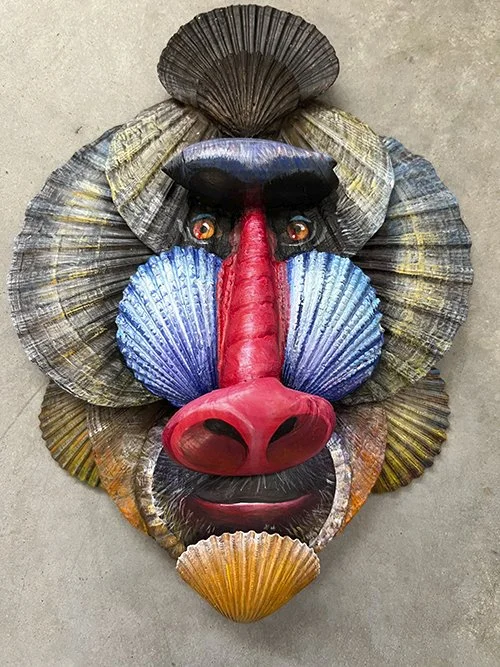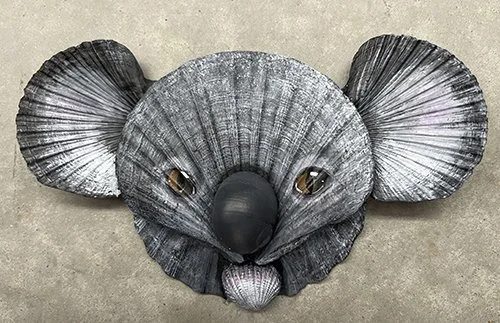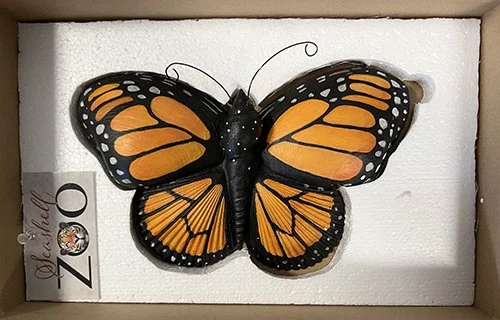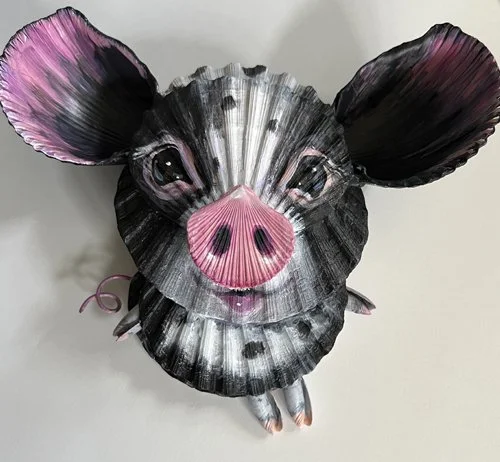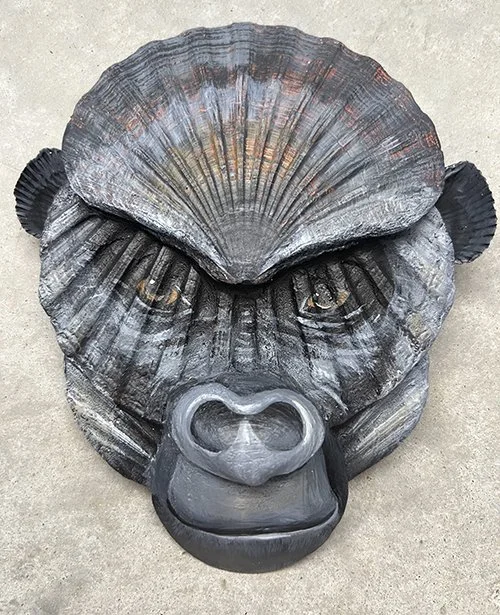I have the good fortune of living in Florida. Seashells that I have been picking up for years along the Atlantic Ocean and Gulf of Mexico shorelines found their way into my art studio in mid-2023. I put a few together, glued, and then painted them to look like each of my three cats. Eventually, I tried a giraffe, a butterfly, and a tiger. At the same time, I was becoming aware of creatures I never knew existed. I am now totally captured by the astounding beauty of life on this planet. I am also aware of the precarious situations of many. Seashell Zoo is a labor of love. Each portrait is my sincere attempt to reflect Earth’s incredible artistic diversity of species, many of which are endangered. They are 100% shells, glue, and paint. As friends began to see what I was creating with shells, several suggested I do seashell portraits of their dogs, cats, and horses. Some are displayed here. Thank you for taking a look!
There are fewer than 3,000 ROYAL BENGAL TIGERS left in the wild of Northern India. A small number live in Bangladesh, Nepal, Indonesia, Vietnam, China, and Myanmar. They inhabit mangrove forests, swamps, and grasslands. These natural born killers can climb trees and are excellent swimmers. Their nighttime vision is 6 times that of humans, hearing is 5 times. They hiss when they fight, and their roar can be heard from 2 miles away. Because their skin and bones are desirable for medicinal purposes in Asia, Royal Bengal tigers are considered to be Most Critically Endangered with poaching being the number one cause.
MANDARIN FISH are found in the Pacific Ocean and are popular in saltwater aquariums. Feeding is perhaps the most challenging aspect of keeping a Mandarin Dragonet. In the wild, these fish primarily feed on live copepods and amphipods. In an aquarium, sustaining a sufficient population of these tiny crustaceans can be difficult. The species has not been given a conservation status, but it is known to be threatened by overfishing and pollution as well as its popularity in the private aquarium trade.
Florida ALLIGATORS reside in and around ponds, lakes, rivers, and marshes in all of the 67 counties in the state. They cannot survive in salt water. Alligator eyes are on the top of their head making it easy to lie almost submerged in water and still see their prey. They consume fish, reptiles, birds, and mammals but aren’t opposed to eating fruit. On cooler days they sunbath on the shoreline. You can tell how big an alligator is by the distance between the eyes: the greater the distance, the longer the alligator. Alligators have about 75 teeth at any one time, but as they are broken off or wear down, they are replaced. They can have as many as 3,000 teeth in a lifetime. They are on the Least Endangered list.
The MOOSE or ELK is the world’s tallest, largest, and heaviest species of deer. It is also the tallest, and second-largest, land animal in North America, falling short only of the American bison in body mass. Moose thrive in cooler, temperate areas as well as subarctic climates. Unlike most other deer species, moose do not form herds and are solitary animals. The moose’s diet consists of terrestrial and aquatic vegetation, with branches, twigs, and dead wood making up a large portion of their winter diet. Predators include wolves, bears, humans, wolverines, and orcas (if swimming in the ocean). After mating season, males drop their antlers to conserve energy for the winter. A new set of antlers will then regrow in the spring.
The WALRUS is a pinniped marine animal living about the North Pole in the Arctic Ocean and subarctic seas off the Northern Hemisphere. Adults can weigh up to 4,400 pounds. During the 19th and early 20th centuries, walrus were hunted for their blubber, ivory tusks, and meat. Consequently, their population dropped rapidly. The species is considered Vulnerable. Due to their great size and tusks, they have only two natural predators: the orca and the polar bear, both which prey on walrus calves.
BONTEBOK
GRIZZLY BEAR
BLUEBIRD
AMERICAN BISON before
AMERICAN BISON after
AMERICAN EAGLE
OKAPI
MANDRILLS are the largest Old World species of monkey. Old World monkeys differ from New World monkeys in having downward-pointing nostrils. The presence of a tail differentiates them from apes. Mandrills are shy and reclusive primates that live only in the rainforests of equatorial Africa. Because they are sociable creatures, they can live in groups as large as 1300. The mandrill is an omnivore that forages for food such as fruit, seeds, stems, leaves, but also, snails, lizards, frogs, and snakes. They are considered to be a pest as they cause significant damage to crops. Their main predators are leopards and humans. Male mandrills are more colorful than any other mammal. They are considered Vulnerable.
AFRICAN LION numbers have declined by over 40% in just 3 generations. Their main threats are retaliatory or preemptive killing to protect people and livestock, and loss of habitat due to expanding human settlements and therefore less available grazing when their natural prey are scarce.
The WHITE RHINOCEROS is the most abundant of the five species of rhinos in the world. It is found in Africa, as is the Critically Endangered Black Rhinoceros. The adults have no real predators other than poachers who kill the 3-ton animal for the horn.
GIRAFFES are the tallest living terrestrial animal on earth. They are scattered throughout the continent of Africa. They stand up a mere half hour after birth and run within 10 hours.
The HIPPOPOTAMUS is native to sub-Saharan Africa. Hippos inhabit rivers, lakes, and mangrove swamps. They are threatened by habitat loss and poaching for their meat and ivory (canine teeth). They are considered Vulnerable.
The ZEBRA is an African equine (member of the horse family) inhabiting eastern and southern African savannas, grasslands, shrublands, and mountainous areas. The zebra is a grazer preyed upon by lions. They are also sought after by exotic animal collectors. The three species of zebras are Endangered, Vulnerable, and Near-threatened.
ELEPHANTS are the largest land mammal walking on Earth. They can be found inhabiting forests and grasslands on the Asian continent, as well as African savannas and forests. All elephants are Endangered to Critically Endangered. Humans are the greatest threat due to poaching. Illegal ivory trade threatens to obliterate the African Forest Elephant in particular.
The RED FOX is a symbol of animal cunning and the subject of folklore. It has the largest natural distribution of any land mammal except human beings. Preferred habitats range from Arctic tundra to arid desert. They adapt very well. On the prairies of North America, it is estimated that red foxes kill close to a million wild ducks each year. The red fox is hunted for sport and for its pelt. In much of their range, red foxes are the primary carrier of rabies. Fox population are often limited by the presence of coyotes.
The Florida BLACK BEAR is a subspecies of the American black bear. They are common in sand-pine scrub, oak scrub, upland hardwood forests and forested wetlands and are the only American black bear subspecies to live in a subtropical region. It is the largest native land mammal in Florida and is shy and secretive, hiding in dense vegetation and rarely seen in the wild. The leading cause of mortality is road traffic collisions.
The KOALA is native to Australia. The species inhabits open Eucalyptus woodlands, as the leaves make up most of the diet. Being marsupials, koalas give birth to underdeveloped young that crawl into their mother’s pouch where they stay for the first 6-7 months of their lives. They have few natural predators but are considered Vulnerable due to their habitat’s destruction caused by agriculture, urbanization, droughts and bushfires.
The RED PANDA (not related to the Giant Panda) has a close affinity to the raccoon, weasel, and skunk. They are an Endangered and protected species living in high altitude, temperate forests of the Eastern Himalayas and Southwestern China. They are very acrobatic, but shy, and stay mostly in trees to avoid confrontation. The red panda has sharp teeth and claws, thick reddish-brown fur, a black belly, and white-lined ears.
The CHIMPANZEE is a species of great ape native to the forests and savannas of tropical Africa. They are Endangered with the biggest threats being habitat loss, poaching, and disease.
NORTHERN ROCKHOPPER PENGUINS are native to southern Indian and Atlantic Oceans. Their numbers have declined by 90% since the 1950’s making them Endangered. This Is one of the smallest crested penguins weighing in at about five pounds. Crested penguins are black and white with yellow crests and red bills and eyes. All lay two eggs but raise only one young per breeding season. The first egg laid is substantially smaller than the second. The Northern Rockhopper Penguin earns its name from its behavior on land as it slides on its belly, as mosts penguins do, but navigates the steep, rocky shores with its strong, thick-skinned feet and legs. A streamlined, torpedo-shaped body and powerful flippers make it an effective diver and swimmer.
The very large SPECTACLED OWL lives in Central and South American tropical lowlands where old-growth rainforests are dense. This is a solitary and unsociable bird characterized by white “spectacles” around its bright yellow eyes. The sounds it makes are like a guttural knocking or tapping. Pup-pup-pup-pup-po. It is not considered to be endangered.
SLOTHS are my personal favorite. They spend their slow and sleepy lives in the trees of tropical rainforests in Central and South America. Long, curved claws on their hands and feet allow them to hang upside down from branches without effort.
The LEOPARD SEAL is the second largest species of seal in the Antarctic. Their only predator is the orca. They are particularly fond of dining on penguin. Leopard seals depend on sea ice for reproduction. Some time in the future their numbers will be reduced due to climate warming.
GREEN SEA TURTLES are the largest hard-shelled sea turtle. They are unique among sea turtles in that they are herbivores, eating mostly seagrasses and algae which is what gives their fat a greenish color. Sea turtles are found in coastal areas throughout the world. Historically, they were exploited for their fat, meat, and eggs, causing their global population to decline. Many countries, including the USA, prohibit the killing of sea turtles and the collection of their eggs. However, in some areas, the killing of green turtles for their meat or to supply shells to the wildlife trafficking trade remains a threat to their recovery. The biggest threats are being caught in commercial or recreational fishing gear, vessel strikes, loss of nesting habitat from coastal development, and climate change. They are classified as Endangered.
SEAHORSES are mainly found in shallow tropical salt water, living in sheltered areas such as seagrass beds, coral reefs, and mangroves They are the slowest-moving fish in the world and swim upright propelling themselves using the dorsal fin. Females transfer their eggs into the male’s brood pouch where the eggs eventually hatch and are released. Like most fish species, seahorses do not nurture their young after birth, leaving infants susceptible to predators or ocean currents. Less than 0.5% survive to adulthood.
Milkweed is the only plant on which the MONARCH BUTTERFLY will lay eggs and the only source of food for baby caterpillars. It is an iconic pollinator. Eastern North American monarchs have an annual south-ward late summer/autumn migration from the northern and central United States and southern Canada to Florida and Mexico. The western North American population often migrates to southern California. Monarchs undergo complete metamorphosis with a life cycle through four phases: egg, larva (caterpillar), pupa, and adult. Commonly, fewer than 10% of monarch eggs and caterpillars survive. In 2009, monarchs were reared on the Inter-national Space Station, successfully emerging from pupae in the station’s Commercial Generic Bioprocessing Apparatus.
BUTTERFLIES
PALOMINO is a genetic color in HORSES consisting of a gold coat and white mane and tail. The degree of whiteness can vary from bright white to yellow. They can be traced back to the Crusades. Due to their beauty and sturdiness, they’ve been a respected choice of horse for many noble leaders, and because of their color, palominos stand out in a show ring and are much sought after as parade horses. They are considered to be amongst the best bloodlines. One of the most famous palomino horses was Roy Rogers’ Trigger. Another famous palomino was Mister Ed.
DONKEYS were domesticated in Africa 5,000-7,000 years ago. They are used mainly as a working animal in underdeveloped countries. Small numbers are kept for breeding or as pets in developed countries. An adult male is a jack or jackass. An adult female is a jenny or jennet. Jacks are often mated with female horses to produce mules. Donkeys are intelligent, cautious, friendly, playful, and eager to learn though they do have a reputations for being stubborn.
Little PIG
WOOD DUCK
Various DOGS that own their people
DACHSHUNDS were a creation of German breeders to scent, chase, and flush out badgers and other burrow-dwelling animals. They are smart and vigilant, with a big-dog bark, making them good watchdogs. Dachshunds are playful, but as hunting dogs can be quite stubborn. They love to chase small animals, birds, and tennis balls with determination and ferocity.
BOSTON TERRIERS are a gentle breed. They have typically strong, happy-go-lucky personalities with a merry sense of humor. They are generally eager to please their owner and can be easily trained. They are very protective of their owners which may result in aggressive and territorial behavior toward other pets and strangers. They are quiet and bark only when necessary. They are a brachycephalic breed of the dog referring to the shortened muzzle which results in a pushed-in appearance of the face. The Boston Terrier’s large, prominent pair of eyes are widely set apart and located squarely in the skull.
Boomer is a WELSH CORGI.
Bishop (with his blue scarf) is a STANDARD POODLE. These dogs are energetic, active, and athletic. They have a hypoallergenic coat that sheds very little. They are above-average in intelligence and trainability. Poodles come in three size varieties. Standards are more than 15 inches tall at the shoulder. Miniatures are 15 inches or under, and toy poodles stand no more than 10 inches.
The ENGLISH BULLDOG is a British breed of dog of mastiff type. It is a medium-sized, muscular dog of around 40-55 pounds. They have large heads with thick folds of skin around the face and shoulders and a relatively flat face with a protruding lower jaw. They are very laid-back with a mellow personality and a crablike waddle.
The FRENCH BULLDOG is also known as a Frenchie. This breed appeared in Paris in the mid-19th century, apparently the result of cross-breeding of Toy Bulldogs imported from England and local Parisian ratters. They are playful, bright, sociable and affectionate, and known as the most popular dog breed worldwide.
Jack is a GOLDENDOODLE. The Goldendoodle was created by crossbreeding a Golden Retriever and a Standard Poodle in the 1990s. It was developed due to the success of the Labradoodle.
SCHNAUZERS originated in Germany from the 14th to 16th centuries. The term comes from the German word for “snout” and means colloquially “mustache” or “whiskered snout.” because of the dog’s distinctively bearded snout. They are energetic and love to play with their people and other dogs. There are three breeds: the Standard, the Giant, and the Miniature. They have above average intelligence.
ENGLISH CREME RETRIEVER
SHIH TZU
Gracie
Quin’s dog
Quin’s other dog
Baxter
Randy the cat
armadillo
The SNOW LEOPARD is a species of large cat in the genus Panthera. It is native to the mountain ranges of Central and South Asia. It is listed as Vulnerable because the global population is estimated to be fewer than 10,000 and is expected to decline by 10% by 2040. It is mainly threatened by poaching and habitat destruction. Snow leopards mostly rest near cliffs and ridges that provide vantage points and shade. They are solitary and actively hunt their prey consisting of domestic livestock. The snow leopard is widely used in heraldry and as an emblem in Central Asia.
WESTERN LOWLAND GORILLAS are found in dense rainforests across the Congo Basin, in the Central Africa Republic, Cameroon, Angola, Equatorial Guinea, and Congo. They are a Most Critically Endangered subspecies due to illegal poaching, disease, and habitat loss blamed on civil unrest.
The HARP SEAL is a species of earless seal (pinniped) native to the northernmost Atlantic Ocean and Arctic Ocean. These sleek swimmers hunt for fish and crustaceans at depths of 300 feet and may dive to nearly 1,000 feet. They are able to remain submerged for up to 15 minutes. There are 4.5 million harp seals in the wild which makes their status Least Concern. However, their cold Arctic home is greatly at risk due to climate change. They depend on ice for raising their young, and this is being greatly impacted by melting sea ice.
The TASMANIAN DEVIL is a carnivorous marsupial. It was formerly present across mainland Australia but became extinct there 3,500 years ago. Today, it is found on the large island of Tasmania which is just south of Australia. In 2008, the species was declared to be Endangered. The large head and neck allow the animal to generate the strongest bite of any predatory land mammal. Despite their name, they are not a threat to humans, preferring to flee rather than fight. They mainly feed upon the carcasses of dead animals.
NORTHERN WHITE-CHEEKED GIBBONS are a Critically-Endangered species native to Vietnam and Laos. They became extinct in China in 2013. Males have black hair, except for distinct white patches on their cheeks, as well as a prominent tuft of hair on the crown of the head. Females are reddish-tan and lack a cranial tuft. Both males and females have unusually long arms. They spend the night sleeping in high branches, often embracing one another tightly. The calls of northern white-cheeked gibbons are among the most complex of those produced by gibbons. The most distinctive calls are those made as part of male-female duets.
OCELOTS are indigenous to the rainforests of Central and South America but can be found from southern Texas to northern Argentina. Similar in size to bobcats, they are members of the cat family. Habitat loss is the greatest threat. As roads are built thru their ranges, they are vulnerable to being hit by cars. Humans have hunted ocelots for their fur, which can be made into expensive fur coats. In 1972, it became illegal to bring ocelots or their skins into the US and other countries. There are now only 120 known ocelots living the U.S. The Texas ocelot is Endangered.
SQUIRREL MONKEYS live in the tropical forests of Central and South America in the canopy layer. The common Squirrel Monkey can be captured for the pet trade or for medical research. Two species are considered Endangered (the Central American Squirrel Monkey) and Vulnerable (the Black Squirrel Monkey).
The PROBOSCIS MONKEY is an arboreal (living in trees) Old World monkey with an unusually large nose, reddish-brown skin color, and a long tail. It is endemic to the southeast Asian island of Borneo and is found mostly in mangrove forests and on the coastal areas of the island. Both sexes have a bulging stomach that resembles a pot belly. Predators include saltwater crocodiles and reticulated pythons as well eagles, large owls, and lizards. Proboscis monkeys are assessed as Endangered. Their population has decreased by more than 50% in the past 50 years due to ongoing habitat loss because of logging and oil palm plantations, and hunting in some areas due to the species being treated as a delicacy, as well as its use in traditional Chinese medicine. The proboscis monkey is protected by law in all regions of Borneo.
frog holding fish
The COLOMBIAN RED HOWLER MONKEY and the VENEZUELAN RED HOWLER are listed as species of Least Concern, but they are heavily hunted for their meat. They are the loudest of all monkeys.
ORANGUTANS are one of the most intelligent great apes. They live in the rainforests of Indonesia and Malaysia. They are the largest arboreal (living in trees) mammal. Their Critically Endangered status is due to losing their jungle homes as a result of forest decimation and also to poaching.
CAMELS were domesticated over 3,000 years ago. They are working animals especially suited to their desert habitat. They are a vital means of transport for passengers and cargo. They can survive for long periods without food and water. One of the most notable traits is the hump or humps where fat is stored for future energy needs. There are three species. The one-humped dromedary makes up 94% of the world’s camel population, and the two-humped Bactrian makes up 6%. The wild Bactrian camel is a separate species and is now Critically Endangered due to being hunted for sport and for meat.
The IBERIAN LYNX is found in southwest Spain on the Iberian Peninsula. Once considered the world’s most endangered feline species, conservation efforts have revived the Iberian Lynx by restoring their natural Mediterranean scrub and forest habitat as well as increasing the abundance of its primary prey, the European rabbit. Also involved was relocating them to new areas and breeding them in controlled environments. It is considered the greatest recovery of a cat species ever achieved through conservation.
The ARCTIC FOX lives on the land and sea ice within the Arctic Circle. A thick fur coat and long, fluffy tail, which the fox wraps around its body to sleep, keep the animal warm. Arctic foxes change their fur color depending on the season. In the winter, their fur morphs into the iconic, thick white coat. But as summer arrives and the snow melts, Arctic foxes shed the coat to a shorter, thinner fur, which comes in a variety of colors. Lemmings are their favorite prey, living in a complex network of tunnels buried deep in the snow. Arctic foxes listen for movement and then jump several feet in the air and nose dive into the snow to catch the prey. The Arctic is warming 3x as fast as the rest of the world which is a cause of concern for the welfare of the Arctic fox.
LLAMAS are native to the mountainous regions of South America. They are primarily pack animals but are also raised as a source of food, wool, hides, cart pulling, therapy, and guardians of other livestock such as sheep. They are very social and communicate by humming. When one llama is angry with another llama, they will stick out their tongue. They can spit green, partially digested food 15 feet or more.
The EMU is the second-tallest living bird after the ostrich. They are only found in Australia. Emus are highly nomadic with a range covering most of the mainland. They are flightless birds but can travel great distances and sprint at 30mph. Females can mate several times in breeding season (May and June). The male does the incubation and nurtures the young. Emus are sufficiently common to be treated as a Least-Concern species. Threats to their survival include predation of their eggs, roadkills, and fragmentation of their habitats.
The GAZELLE is an antelope species found in deserts, grasslands, and savannas of Africa, as well as Southwest and Central Asia and India. It is a totem animal of many African families. A totem animal is a spirit called upon or invoked for its special powers and survival skills.
The POLAR BEAR is the largest land predator on earth. Adults can weigh 1,760 pounds and stand 11 feet tall. It spends most of its life on the sea ice of the Arctic Ocean. Unlike brown bears and black bears, polar bears do not hibernate though pregnant females winter in dens. The polar bear eats seals and Arctic fox and can sprint at 25mph. When not hunting, polar bears rest up to 20 hours a day. They build nest-like beds in seaweed piled up on the coast and dig deep caves of snow into bluffs. They also like to build shallow snow beds and let blowing snow cover them. Built to stay warm, they sometimes overheat and have to cool off in the chilly water. The population is decreasing due to climate change, hunting, mineral and energy resource exploration, shipping, tourism related activities, and disease. Polar bears are considered Vulnerable.
LEMURS are primates, an order that includes monkeys, apes, and humans. They are endemic to the island of Madagascar. True lemurs include about 20 species. The best known is the ring-tailed lemur commonly seen in zoos. Lemurs are docile, gregarious animals. Troops are made up of several males and females. Females are the dominant sex. Most lemurs spend their time in trees eating fruit, leaves, insects, and small birds and bird eggs. Their eyes are adapted for nocturnal life. A number of lemurs are Endangered.
MARMOSETS are a numerous species of small long-tailed South American monkeys. They are tree-dwelling primates similar in appearance to squirrels. Claws on all digits, except for the big toe, aid them in scampering along branches where they eat insects, fruit, tree sap, and small animals. Marmosets have been kept as pets since the 17th century but require knowledgeable care to remain healthy. They are tropical animals needing a warm climate. They are also very intelligent and easily bored. Being highly social in the wild, they create stable social groups. To keep them alone is cruel and unnatural.
GIANT RIVER OTTERS are carnivorous members of the weasel family. They are 3-6 feet from head to tail and live along the Amazon River. They construct large campsites close to feeding areas and clear large amounts of vegetation, They have a wing-like tail and webbed feet allowing them to be both amphibious and terrestrial. They are a top predator in aquatic systems controlling prey species population sizes to keep the river ecosystem in balance. Decades of poaching for their velvety pelt has considerably diminished their numbers. The species was listed as Endangered in 1999.
The GRAY WOLF is a large canine native to Eurasia and North America. They are the wild ancestor of all our domesticated dogs, from poodles to bulldogs to greyhounds. Wolves survive by preying on large animals such as elk, deer, and moose. They are highly social and form tight packs of four to seven. Wolves use dens for the rearing of their young. Wolf pups are born blind and deaf, and they must be cared for until they mature at ten months of age. Once the world’s most widely distributed mammal, the gray wolf’s range has been reduced by one-third. They are commonly killed in revenge after they kill livestock, or in fear of attack on humans. After the last wolf was killed in Yellowstone National Park in 1926, a reintroduction program was implemented in 1995. Wolves are now reproducing at a rapid rate.
The GIANT PANDA is a bear species endemic to China. Bamboo shoots and leaves make up 99% of their diet. As a result of farming, deforestation, and other development, the Giant Panda has been driven out of lowland areas where it once lived. It is a conservation-reliant Vulnerable species. The Giant Panda has often served as China’s national symbol.
The NORTHERN MURIQUI MONKEY is endemic to Brazil and is known as a woolly spider monkey because it exhibits the woollen pelt of woolly monkeys and the long prehensile (capable of grasping) tail of spider monkeys. This species requires a great deal of space to swing through trees, and has a diet consisting of leaves, twigs, and some fruit. Muriquis use their tail to hang upside-down while eating. The Northern muriqui is classified as Critically Endangered, being one of the world’s most endangered primates. It is threatened by hunting, and destruction and fragmentation of Brazil’s Atlantic Forest. Muriquis are not like other primates. While baboons and chimps engage in violence and aggression, muriquis live in peaceful, egalitarian societies.
AFRICAN PAINTED DOGS are part of the same family as wolves and coyotes. They are also known as African wild dogs or Cape hunting dogs. They live in grasslands, plains and savannas in Africa. They are the largest wild canine in Africa. The species has been largely exterminated in North and West Africa and is considered Endangered largely due to habitat loss. African painted dogs have strong bonds. Solitary living and hunting are extremely rare in the species. Permanent packs consist of 2 to 27 adults and pups.
The FLAMINGO is a wading bird distributed throughout the Americas. Two species are native to Afro-Eurasia. Flamingos are famous for their bright pink feathers, stilt-like legs, and S-shaped neck. When a flamingo spots potential dinner (shrimp, snails, algae), it plunges its head into the water, twists it upside down, and scoops the meal using its upper beak like a shovel. They are able to run on the water, because of their webbed feet, to gain speed before lifting up into the sky. Flamingos build nests that look like mounds of mud along waterways. At the top of the mound, in a shallow hole, the female lays one egg. The parents take turns sitting on the egg to keep it warm. After 30 days, the egg hatches. A group of flamingos is called a flamboyance. Most flamingo species arenot endangered, although the Andean flamingo is listed as Vulnerable.
GALLERY VIEW













